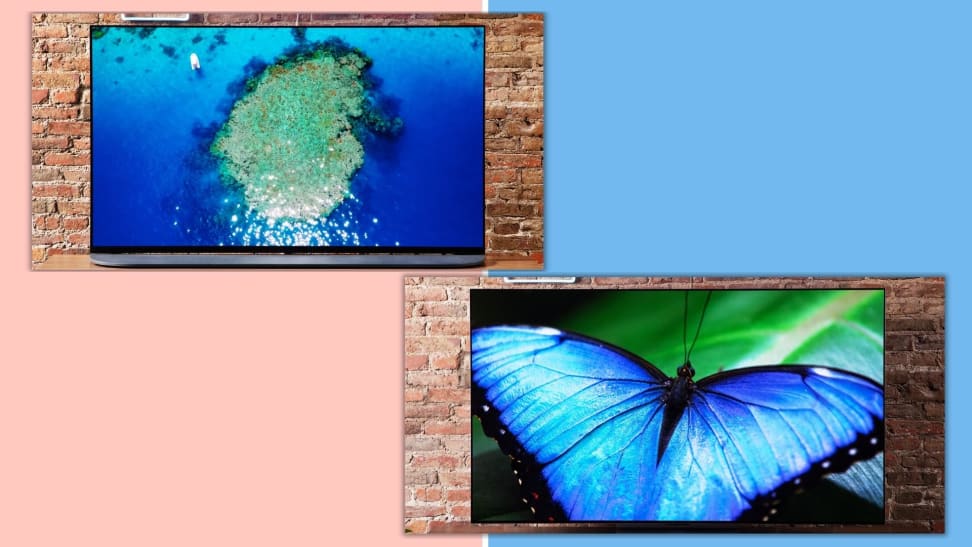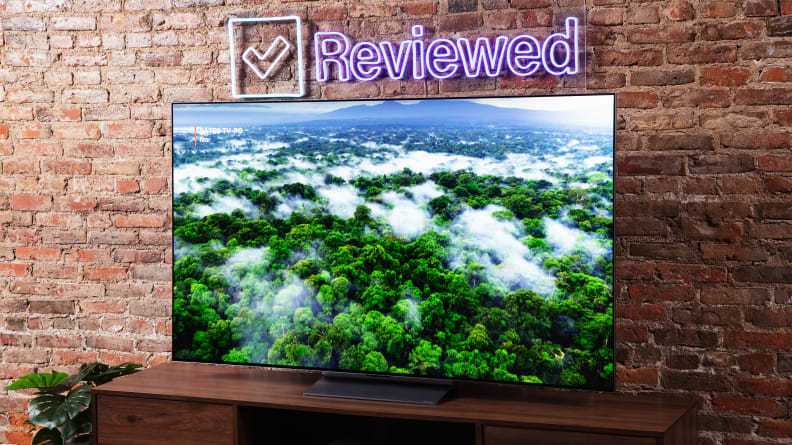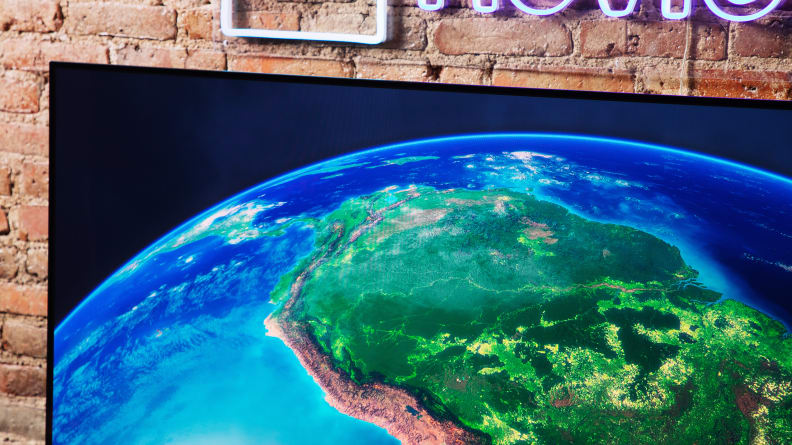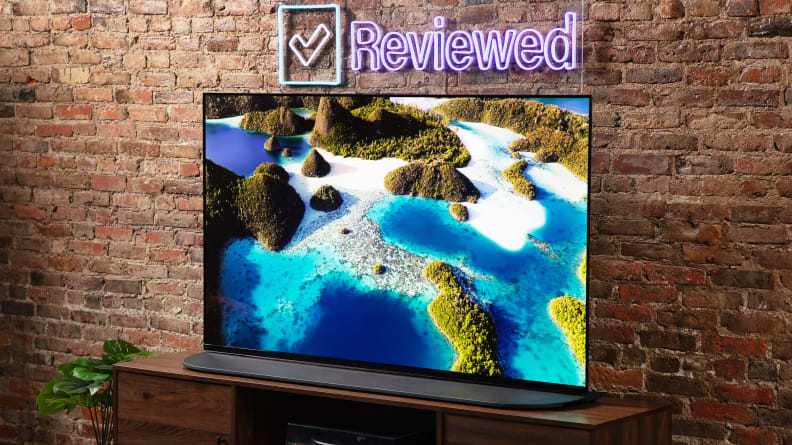LG G2 VS SONY A95K: WHICH OLED COMES OUT ON TOP?
he best OLEDs from LG and Sony duke it out.
 Credit: Reviewed / Tim Renzi
Credit: Reviewed / Tim Renzimendations are independently chosen by Reviewed's editors. Purchases made through the links below may earn us and our publishing partners a commission.
The LG G2 and the Sony A95K are two of the best TVs I’ve ever seen. These top-shelf marvels of technology don’t come cheap, but they feature incredible picture quality, unique designs, and an array of features that will keep them on the cutting edge for years to come.
If you’ve already decided to invest a pretty penny in your next TV, deciding between these two titans can be tough. We’ve spent hours diligently testing each, so we’re ready to help you make the call. Here’s how they compare, from price to performance.
Buy the Sony A95K at Amazon
Fall is here, let's get cozy. We're giving away a Solo Stove Bonfire with a stand. Enter to win between now and Nov. 18, 2022.
Price
These TVs are still relatively new at the time of publishing, so you’ll likely have to wait a bit longer to see steep discounts on each. Given their ultra-premium status, however, even the deepest of discounts won’t put them into a price bracket most of us would deem affordable.
Here’s what you can expect to pay for the models in each series.
LG G2:
- 55-inch (LG OLED55G2PUA), MSRP $2,199.99
- 65-inch (LG OLED65G2PUA), MSRP $3,199.99
- 77-inch (LG OLED77G2PUA), MSRP $4,199.99
- 83-inch (LG OLED83G2PUA), MSRP $6,499.99
- 97-inch (LG OLED97G2PUA), MSRP $24,999.99
The G2 is available in five sizes. The standard 55- and 65-inch options are accounted for, along with three extra-large sizes: 77 inches, 83 inches, and a ridiculously big 98-inch model that’ll set you back $25,000.
Sony A95K:
- 55-inch (Sony XR-55A95K), MSRP $2,999.99
- 65-inch (Sony XR-65A95K), MSRP $3,999.99
The Sony A95K, meanwhile, is only available in two sizes: 55 and 65 inches. It’s the most expensive TV we’ve seen this year, with the 55-inch model priced around $3,000 (almost the same as the 65-inch G2).
Between the G2’s added size options and lower price point, this one is an easy call.
Our pick: LG G2

More size options and better prices guarantees victory for this one.
Performance
Both the LG G2 and the Sony A95K are OLED TVs. Since OLEDs don’t rely on a backlight like traditional LCD/LED TVs, their self-illuminating pixels are able to shut off independently, producing perfect black levels. This has a number of positive impacts on several other areas of performance, including color, clarity, and off-angle viewing.
The A95K, however, is one of the first of its kind: an OLED TV that also uses quantum dots, which are color- and brightness-boosting crystals that, until now, were only found in LCD/LED TVs. In a nutshell, quantum-dot OLEDs bypass the use of color filters, allowing for higher luminance and a wider color gamut.
The LG G2, on the other hand, is not a QD-OLED TV. Like most OLEDs, the G2 uses white light and color filters when producing its picture. This, ostensibly, puts the G2 at a disadvantage when it comes to overall brightness and color volume.
But the G2 isn’t a slouch. In fact, it’s the best LG OLED we’ve ever tested. It’s equipped with top-notch picture processing and a heatsink that allows for higher light output than previous iterations without extra heat that could damage the electronics. This expert blend of software and hardware makes for one hell of a picture. With a peak brightness of around 900 to 950 nits, the G2 is the brightest OLED TV LG has ever produced. For comparison, the next-best LG OLED this year—the C2—tops out at around 800 nits.
Its color production is also spectacular. According to our lab tests, the G2 covers an impressive 99% of the HDR color gamut (DCI-P3). Its out-of-the box color in Filmmaker picture mode is also quite accurate. In real-world terms, this means you can expect HDR10 and Dolby Vision content to look vibrant and cinematic.
Despite these triumphs, the G2 would appear to have met its match in the Sony A95K. Sony’s first attempt at blending quantum dots with a self-emissive OLED display is nothing short of a technical marvel. It’s not that much brighter than the G2 (its peak brightness is just a hair above the G2’s at around 950 to 1,000 nits), but the added “oomph” goes a long way toward imbuing HDR content with visual depth.
Colors on the A95K look brighter and bolder, too, on account of them being produced without the use of traditional OLED color filters. According to our tests, the A95K covers a gobsmacking 100% of the HDR color gamut. Sony’s oft-lauded picture processing is another key ingredient; the A95K is expertly calibrated right out of the box in its Custom picture mode, and its visual expression is incredibly clear and lifelike.
Both of these TVs are among the best I’ve ever seen, but the A95K is simply the best. It’s a close one, but the A95K comes out on top.
Our pick: Sony A95K

Space documentaries are quite a treat with the colors this TV provides.
Design
The G2 “Gallery” OLED gets its name from its design, as it’s intended to hang on the wall like a portrait. For people planning on using a more traditional, tabletop setup, an optional stand for the G2 is sold separately. Unfortunately, we find the stand to be a somewhat inelegant setup, as it introduces an unsettling amount of wobble and also causes the panel to lean backward which feels like an unfortunate byproduct of its design rather than an intentional choice. It offers more room for a soundbar than the A95K and you’ll probably get used to the panel’s slight tilt, but anyone on the fence about this particular design flourish should be wary.
The G2 being designed from the ground up for wall-mounting has its advantages if you do intend to wall-mount it. Its ultra-thin wall bracket (included with the TV) keeps the G2 closer to the wall than traditional wall-mounting brackets, and its narrow, silver frame completes the art gallery look. Simply put, there’s not a better-designed wall-mounted TV on the market today.
The A95K, however, is a much better fit for folks who intend to place their next TV on a media console. There are two ways to attach the A95K’s heavy, metallic stand to the base of the panel. Its front-facing formation puts the base in front of the screen, while the back-facing position creates the illusion that the A95K is standing up on its surface unattended. In either setup, you’ll need a media console deep enough to accommodate the depth of the stand, and the front-facing formation allows the TV to sit as close as it possibly can to the wall behind it.
Like the G2, the A95K’s back-facing stand setup will cause the panel to lean back ever so slightly. In the A95K’s case, however, the lean is more subtle and deliberate-looking, and the TV’s heavy base ensures that the panel is stable and wobble-free.
And although LG’s latest iteration of its Magic Remote gets the job done, I’ve got to shout-out the A95K’s excellent remote control. It features a backlit design, so every time you pick it up, the buttons glow in the dark.
Despite the G2’s gorgeous, portrait-like design, if you don’t intend on wall-mounting your TV, the A95K is a better fit. It’s top-tier remote control is just icing on the cake.
Our pick: Sony A95K

The better option for the traditional table setup.
Features and smart platform
Before we discuss the features that set the G2 and A95K apart, let’s take a look at the features they share.
- Resolution: 4K (3,840 x 2,160)
- Display type: OLED
- HDR support: HDR10, HLG
- Dolby Atmos: Yes (native decoding)
- eARC support: Yes
- Native refresh rate: 120Hz
- Variable Refresh Rate (VRR): Yes
- Auto Low Latency Mode (ALLM): Yes
- Other features: Nvidia G-Sync compatibility, Filmmaker Mode, Amazon Alexa, Google Assistant, Apple AirPlay 2, ASTC 3.0 tuner, hands-free voice control
Starting with gaming features, the G2 and the A95K both come with Variable Refresh Rate (VRR) and Auto Low Latency Mode (ALLM) for smoother, low-latency gaming. In addition, both TVs are compatible with Nvidia G-Sync, but only the G2 supports AMD’s FreeSync Premium.
The G2 features four HDMI 2.1 ports that support 4K gaming at 120Hz with a bandwidth of 48Gbps. The A95K, however, only features two such ports, and one of them is the TV’s dedicated eARC port. This means that if you own (or plan on owning) an Xbox Series X, a PlayStation 5 and an eARC-enabled soundbar or home theater receiver, one of your next-gen consoles will either have to use one of the performance-limiting HDMI 2.0 ports or run through your sound system. With the G2, you’re not forced to make these decisions. On the cinematic side of things, both models offer the same HDR support (including Dolby Vision). The G2 and A95K also decode Dolby Atmos natively, though only the A95K supports DTS audio, as LG stopped supporting DTS a few years ago.
This brings us to each TV’s dedicated smart platforms. The G2 is running the newest version of LG’s webOS. You’ll likely find yourself dodging sponsored content on its home screen, but webOS zips along with minimal slowdown and navigation is relatively simple.
The A95K is running Google TV, and compared to the latest iteration of LG’s webOS, it’s a breath of fresh air. It’s not our favorite way to stream (that honor goes to Roku), but if you’re relying on the A95K’s built-in smart features for everyday streaming, you won’t be let down. Both platforms organize their apps on a home screen in a similar fashion, but Google TV’s user interface is easier to navigate.
This category is too close to call. If you intend on using your next TV’s smart platform every day, the A95K’s software is preferable. If you’re a dedicated gamer, however, the G2 is a much friendlier option; all of its HDMI ports are ready for next-gen gaming, and you’ve got FreeSync in your back pocket.
Our pick: Draw
And the winner is…
It’s a tie.
From a performance standpoint, both the G2 and the A95K are among the top three TVs you can buy right now. The G2 comes in more sizes at more affordable prices, but my lab tests—and my eyes—tell me that the A95K sports the best picture I’ve ever seen. The G2 is the best a wall-mounted TV has ever looked, but the A95K is much more stable (and better-looking) when sitting on a media console.
And although the G2 is one of the best (if not the best) gaming TV you can buy right now, the A95K’s Google-based smart platform is faster and easier to use than LG’s.
Ask yourself three questions: How much do I want to spend? Do I want to wall-mount my next TV? Most importantly, though, ask yourself how much gaming you intend to do in the coming years.
Both of thest TVs will blow your socks off, but depending on what you plan on doing with your next TV, one is better-suited for you than the other.
Comments
Post a Comment